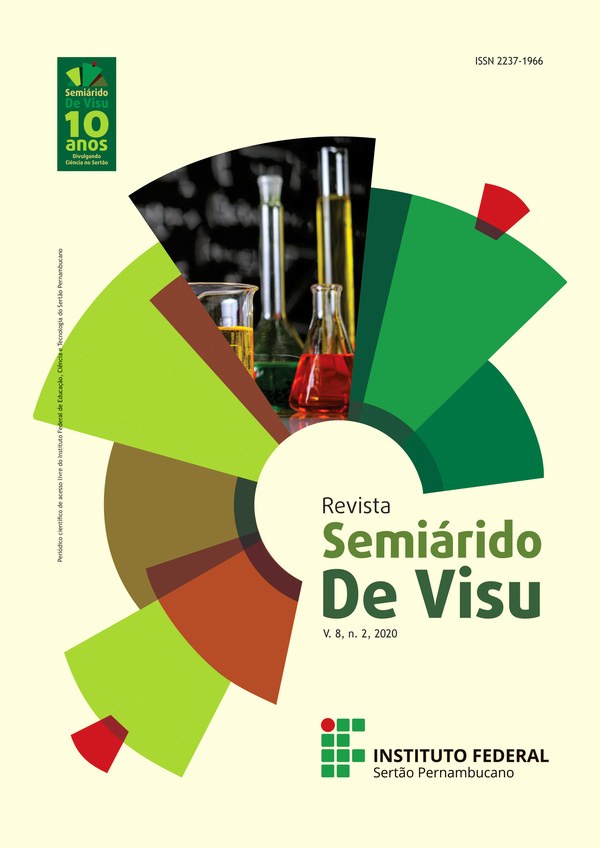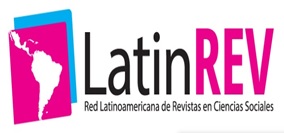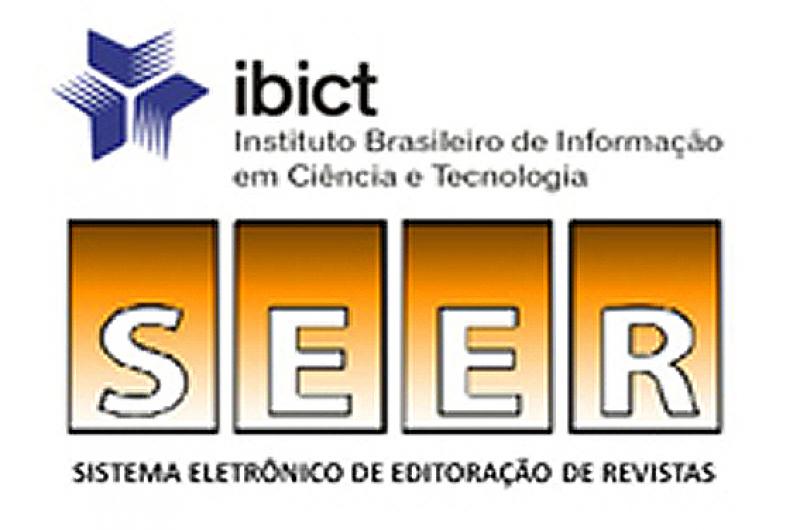Oportunidades da Química Teórica e Computacional para a Iniciação Científica
Visualizações: 831DOI:
https://doi.org/10.31416/rsdv.v8i2.43Palavras-chave:
Mecânica Quântica, Pesquisa Científica, Modelagem MolecularResumo
Este trabalho apresenta uma introdução à química teórica e computacional e as inúmeras possibilidades de linhas de pesquisa que a área pode oferecer para o ingresso à iniciação científica no ensino básico e superior, por intermédio de um curso de extensão universitária ministrado na VIII Semana de Química e Meio Ambiente do Instituto Federal de Educação, Ciência e Tecnologia do Sertão Pernambucano – Campus Ouricuri. O minicurso teve duração de três dias, com carga horária total de 9 horas. Foram realizados estudos-piloto com ênfase nos aspectos práticos da modelagem molecular, onde os participantes tiveram a oportunidade de manipular softwares de química computacional, para o cálculo de propriedades geométricas e eletrônicas de moléculas orgânicas. As práticas possibilitaram uma ampla divulgação da área que, até então, ainda se encontra pouco difundida no meio acadêmico. O minicurso serviu como motivação para o registro de três projetos científicos voluntários na área de química computacional.
Referências
ACD/ChemSketch, version 2.1, Advanced Chemistry Development, Inc., Toronto, ON, Canada, www.acdlabs.com, 2015.
ANIKIN, N. A.; ANISIMOV, V. M.; BUGAENKO V. L.; BOBRIKOV V. V.; ANDREYEV, A. M. LocalSCF method for semiempirical quantum-chemical calculation of ultralarge biomolecules. The Journal of Chemical Physics, v. 121, n. 3, p. 1266-1270, 2004.
BAKER, J. An algorithm for the location of transition states. Journal of Computational Chemistry,v. 7, n. 4, p. 385-395, 1986.BIOVIA, Dassault Systemes.
BIOVIA Discovery Studio Visualizer, v16. 1.0. 15350, San Diego: Dassault Systemes; 2015 [cited: 2018 Dez 30].
BRASIL, Ministério daCiência e Tecnologia. Conselho Nacional de Desenvolvimento Científico e Tecnológico. Anexo III da RN-017/2006: bolsas por quota no país; Pibic –norma específica. 2007. Disponível em: <http://www.cnpq.br/web/guest/view/-/journal_content/56_INSTANCE_0oED/10157/100352> Acesso em: 18 jun. 2018.
BURLEY, Stephen K. et al. Protein Data Bank (PDB): the single global macromolecular structure archive. In: Protein Crystallography. Humana Press, New York, NY, 2017. p. 627-641.
CAPARLAR, C. Ö.; DÖNMEZ, A. What is scientific research and how can it be done? Turk J Anaesthesiol Reanim,v. 44, n. 4, p. 212-218, 2012.
CENAPAD-SP. Institucional: sobre o CENAPAD-SP. 2018a. Disponível em: <https://www.cenapad.unicamp.br/home/maim.shtml> Acesso em: 16 dez. 2018.
CENAPAD-SP. Publicações: produção científica. 2018b. Disponível em: <https://www.cenapad.unicamp.br/diversos/prod_cient/prod_cient.shtml> Acesso em: 16 dez. 2018.
FELLER, S. E.; DALLINGER, R. F.; MCKINNEY, P. C. A program of computational chemistry exercises for the first-semester general chemistry course. Journal of Chemical Education,v. 81, n. 2, p. 283-287, 2004.
FROIMOWITZ, M. Hyperchem: a software package for computational chemistry and molecular modeling. Biotechniques,v. 14, n. 6, p. 1010-1013, 1993.
Gaussian 16, Revision B.01, FRISCH, M. J.; TRUCKS, G. W.; SCHLEGEL, H. B.; SCUSERIA, G. E.; ROBB, M. A.; CHEESEMAN, J. R.; SCALMANI, G.; BARONE, V.; PETERSSON, G. A.; NAKATSUJI, H.; LI, X.; CARICATO, M.; MARENICH, A. V.; BLOINO, J.; JANESKO, B. G.; GOMPERTS, R.; MENNUCCI,B.; HRATCHIAN, H. P.; ORTIZ, J. V.; IZMAYLOV, A. F.; SONNENBERG, J. L.; WILLIAMS-YOUNG, D.; DING, F.; LIPPARINI, F.; EGIDI, F.; GOINGS, J.; PENG, B.; PETRONE, A.; HENDERSON, T.; RANASINGHE, D.; ZAKRZEWSKI, V. G.; GAO, J.; REGA, N.; ZHENG, G.; LIANG, W.; HADA, M.; EHARA, M.; TOYOTA, K.; FUKUDA, R.; HASEGAWA, J.; ISHIDA, M.; NAKAJIMA, T.; HONDA, Y.; KITAO, O.; NAKAI, H.; VREVEN, T.; THROSSELL, K.; MONTGOMERY, J. A., JR.; PERALTA, J. E.; OGLIARO, F.; BEARPARK, M. J.; HEYD, J. J.; BROTHERS, E. N.; KUDIN, K. N.; STAROVEROV, V. N.; KEITH, T. A.; KOBAYASHI, R.; NORMAND, J.; RAGHAVACHARI, K.; RENDELL, A. P.; BURANT, J. C.; IYENGAR, S. S.; TOMASI, J.; COSSI, M.; MILLAM, J. M.; KLENE, M.; ADAMO, C.; CAMMI, R.; OCHTERSKI, J. W.; MARTIN, R. L.; MOROKUMA, K.; FARKAS, O.; FORESMAN, J. B.; FOX, D. J. Gaussian, Inc., Wallingford CT, 2016.
HANWELL, M.; CURTIS, D. E.; LONIE, D. C.; VANDERMEERSCH, T.; ZUREK, E.; Avogadro: an advanced semantic chemical editor, visualization, and analysis platform. Journal of cheminformatics, v. 4, n. 1, p. 17, 2012.
HARTREE, D. R. The wave mechanics of an atom with a non-Coulomb central field. Part I, II e III. Mathematical Proceeding of the Cambridge Philosophical Society,v. 24, n. 1 a 3, p. 89-437, 1928.
HEHRE, W. J.; YU, J.; KLUNZINGER, P. E.; LOU, L. Spartan Software. Wavefunction. Inc., Irvine, 2000.
HEISENBERG, W. Über den anschaulichen inhalt der quantentheoretischen kinematik und mechanik. Zeitschrift für Physik,v. 43, n. 3-4, p. 172-198, 1927.
HUEY, R.; MORRIS, G. M. AutoDock tools. La Jolla, CA, USA: The Scripps Research Institute, 2003.
HUNTER, A-B; LAURSEN, S. L; SEYMOUR, E. Becoming a scientist: the role of undergraduate research in students’ cognitive, personal, and professional development. Science Education,v. 91, n. 1, p.36-74, 2006.
Hypescience. Estranho mapa do mundo baseado na produção científica. Disponível em: <https://hypescience.com/mapa-mundo-ciencia-producao-cientifica/> Acesso em 16 nov. 2018.
IUPAC. Glossary of terms used in medicinal chemistry (IUPAC Recommendations 1998). Pure & Appl. Chem.,v. 70, n. 5, p. 1129-1143, 1998.
JIANG, F.; KIM, S-H. “Soft docking”: matching of molecular surface cubes. Journal of Molecular Biology,v. 219, n. 1, p. 79-102, 1991.
JIAO, Y.; YOUNG-MOO, C.; DUAN, H.; LEAL, W. S. Selectivity of odorant-binding-proteins from the southern house mosquito tested against physiologically relevant ligands. Frontiers Physiology,v. 6, n. 56, 2015. doi: 10.3389/fphys.2015.00056.
Jmol: an open-source Java viewer for chemical structures in 3D.Disponível em: <http://www.jmol.org/> Acesso em: 26 dez. 2018.
KENT, W. J. BLAT—the BLAST-like alignment tool. Genome Research,v. 12, n. 4, p. 656-664, 2002.
KIM, S.; THIESSEN, P. A.; BOLTON, E. E.; CHEN, J.; FU, G.; GINDULYTE, A.; WANG, J. PubChem substance and compound databases. Nucleic Acids Research,v. 44, n. D1, p. D1202-D1213, 2015.
LATOUR, B.; WOOLGAR, S. A vida de laboratório: a produção dos fatos científicos. Rio de Janeiro: Relume Dumará, 1997.
LAZARIDIS, T.; KARPLUS, M.; Effective energyfunctions for protein structure prediction. Current Opinion in Structural Biology,v. 10, n. 2, p. 139-145, 2000.
LINSTROM, P. J.; MALLARD, W. G. NIST Chemistry webbook; NIST standard reference database No. 69. 2001.
LUDKE, M.; ANDRÉ, M. E. D. A. Pesquisa em educação:abordagens qualitativas. São Paulo, Editora Pedagógica e Universitária, 1986.
MAHRAM, A.; HERBORDT, M. C. Fast and accurate NCBI BLASTP: acceleration with multiphase FPGA-based prefiltering. In: Proceedings of the 24th ACM International Conference on Supercomputing. ACM, 2010. p. 73-82.
MAO, Y.; XU, X.; XU, W.; ISHIDA, Y.; LEAL, W. S.; AMES, J. B.; CLARDY, J. Crystal and solution structures of an odorant-binding protein from the southern house mosquito complexed with an oviposition pheromone. Proceedings of the National Academy of Sciences of the United States of America, v. 107, n. 44, p. 19102-19107, 2010.
MASSI, L.; QUEIROZ, S. T. Estudos sobre iniciação científica no Brasil: uma revisão. Cadernos de Pesquisa,v. 40, n. 139, p. 173-197, 2010.
MENG, X. Y.; ZHANG, H. X.; MEZEI, M.; CUI, M. Molecular docking: a powerful approach for structure-based drug discovery. Current Computer-Aided Drug Design,v. 7, n. 2, p. 146-157, 2011.
MOPAC2016, James J. P. Stewart, Stewart Computational Chemistry, Colorado Springs, CO, USA, (2016).
MOREIRA, M. A. Modelos científicos, modelos mentais, modelagem computacional e modelagem matemática: aspectos epistemológicos e implicações para o ensino. Revista Brasileira de Ensino de Ciência e Tecnologia,v. 7, n. 2, 2014. doi: 10.3895/S1982-873X2014000200001.
NOGUEIRA, M. A.; CANNAN, M. G. Os “iniciados”: os bolsistas de iniciação científica e suas trajetórias acadêmicas. TOMO,n. 15, p. 41-70, 2009.
OGLE, D. M. K-W-L: A teaching model that develops active reading of expository text. The Reading Teacher,v. 39, n. 6, p. 564-570, 1986.
PEARSON, J. K. Introducing the practical aspects of computational chemistry to undergraduate chemistry students. Journal of Chemical Education,v. 84, n. 8, p. 1323-1325, 2007.
PELOSI, P.; MAIDA, R. Odorant-binding proteins in insects. Comparative Biochemistry and Physiology Part B: Biochemistry and Molecular Biology,v. 111, n. 3, p. 503-514, 1995.
PELOSI, P.; MASTROGIACOMO, R.; IOVINELLA, I.; TUCCORI, E.; PERSAUD, K. C. Structure and biotechnological applications of odorant-binding proteins. Applied Microbiology and Biotechnology,v. 98, n. 1, p. 61-70, 2014.
PLANCK, M. Zur Theorie des Gesetzes der Energieverteilung im Normalspectrum. Verhandlungen der Deutschen Physikalischen Gesellschaft, vol. 2, p. 237-45, 1900. English translation by D. ter Haar 1967 The Old Quantum Theory (Pergamon Press).
ROCHA, G. B.; FREIRE, R. O.; SIMAS, A.M.; STEWART, J. J. P. RM1: A reparameterization of AM1 for H, C, N, O, P, S, F, Cl, Br, and I. Journal of Computational Chemistry,v. 27, n. 10, p. 1101-1111, 2006.
RUNGE, E.; GROSS, E. K. U. Density-Functional Theory for time-dependent systems. PhysicalReview Letters, v. 52, n. 2, p. 997-1000, 1984.
SANCHEZ, R.; ŠALI, A. Advances in comparative protein-structure modelling. Current Opinion in Structural Biology,v. 7, n. 2, p. 206-214, 1997.
SANTOS, E. O.; SILVA, I. P. Revisão acerca do tema simulaçõescomputacionais no ensino de química (2008-2017). Debates em Educação, v. 12, n. 27, p. 841-855, 2020.
SBQT. Apresentação -Simpósio Brasileiro de Química Teórica 2017. <http://www.sbqt2017.if.usp.br/>. Acesso em 20 dez. 2018.
SCHMIDT, M. W.; BALDRIDGE, K. K.; BOATZ, J. A.; ELBERT, S. T.; GORDON, M. S.; JENSEN, J. H.; WINDUS, T. L. General atomic and molecular electronic structure system. Journal of Computational Chemistry,v. 14, n. 11, p. 1347-1363, 1993.
SCHRÖDINGER, E. An undulatory theory of the mechanics of atoms and molecules. Physical Review,v. 28, n. 6, 1949-1970, 1926.
SCHWEDE, T.; KOPP, J.; GUEX, N.; PEITSCH, M. C. SWISS-MODEL: an automated protein homology-modeling server. Nucleic acids research,v. 31, n. 13, p. 3381-3385, 2003.
SHAO, Y. et al. Advances in molecular quantum chemistry contained in the Q-Chem 4 program package. Molecular Physics,v. 113, n. 2, p. 184-215, 2015.
SILVA, V. B.; SILVA, C. H. T. P. Modelagem de proteínas-alvo por homologia estrutural. Revista Eletrônica de Farmácia,v. 4, n. 1, p. 15-26, 2007.
STEWART, J. J. P. Application of localized molecular orbitals to the solution of semiempirical self-consistent field equations. International Journal of Quantum Chemistry,v. 58, n. 2, p. 133-146, 1996.
TAYLOR, R. D.; JEWSBURY, P. J.; ESSEX, Jonathan W. A review of protein-small molecule docking methods. Journal of Computer-Aided Molecular Design,v. 16, n. 3, p. 151-166, 2002.
TROTT, O.; OLSON, A. J.; AutoDock Vina: improving the speed and accuracy of docking with a new scoring function, efficient optimization, and multithreading. Journal of Computational Chemistry,v. 31, n. 2, p. 455-461, 2010.
ZERNER, M. C. Semiempirical molecular orbital methods. Reviews in Computational Chemistry,p. 313-365, 1991.















